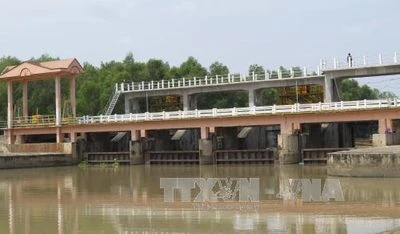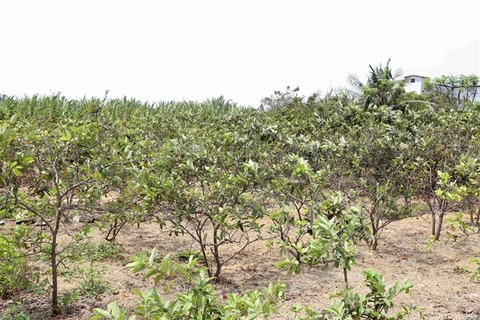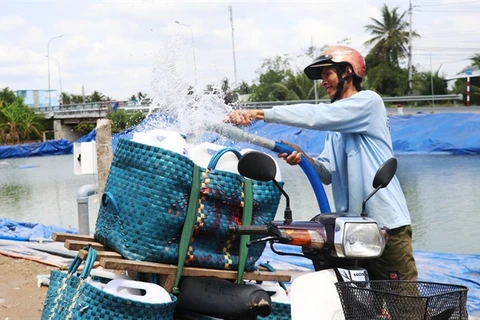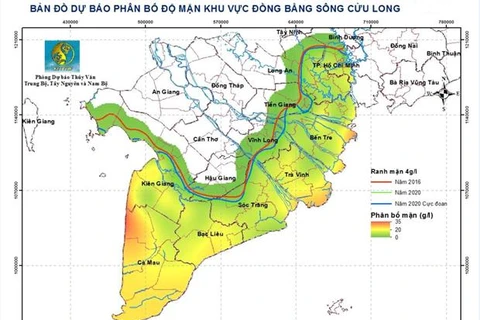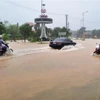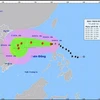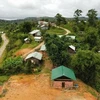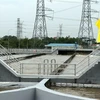Hanoi (VNA) – Another drought has come, but this time it is even more extreme than in previous years. Since the beginning of the 2019 – 2020 dry season, the Mekong Delta has undergone five spells of saltwater intrusion that have considerably affected agricultural production and people’s lives.
For the remaining months of the dry season, water flows on rivers are forecast to remain very low, posing high risks of continued serious drought and water scarcity.
Given this, joining hands with local residents to seek water supply sources to mitigate impact of drought and saltwater intrusion is now a task as urgent as the fight against COVID-19.
Saline encroachment stays high
According to the Vietnam Meteorological and Hydrological Administration at the Ministry of Natural Resources and Environment, saltwater intrusion at the mouth of the Cuu Long (Mekong) River has gradually abated. However, as flows from the upper river haven’t been improved, salinity remains high, and heat and drought keep going on.
So far, five provinces in the region have declared a state of emergency over drought and seawater invasion, namely Long An, Tien Giang, Ben Tre, Kien Giang, and Ca Mau.
[Saltwater intrusion in Mekong Delta to abate but concerns remain]
Mai Van Khiem, Director of the National Centre for Hydro-Meteorological Forecasting, said the current spell of saltwater intrusion will last until around April 15.
During this period, localities should limit irrigation to minimise damage to crops, he said, suggesting them check salinity before watering.
After that salinity will reduce gradually but stay high on the Vam Co and Cai Lon rivers until the end of April.
The Mekong River’s flows into the region in April will still be 5 – 20 percent lower than the average and 2016, when historic drought was recorded, and unlikely to supply more water for the agricultural hub.
Localities need to gear up for the scenario that drought and saltwater intrusion may linger on, the forecasting centre noted.
Echoing the view, the Standing Office of the Vietnam National Mekong Committee said saltwater intrusion in April will ease compared to March but remain serious.
[Mekong Delta provinces get help to cope with drought]
Accordingly, the strongest encroachment of the salinity level of 4 grammes per litre on the Hau, Tien and Vam Co Tay rivers, which are distributaries of the Mekong River, will be 20 – 28km deeper than the average and 3 – 8km deeper compared to April 2016.
Likewise, the strongest intrusion of the salinity level of 1 gramme per litre on these rivers will be 29 – 41km deeper than the average and 3 – 16km deeper than April 2016.
Basing on these projections, the Standing Office said rice seeds for the summer – autumn crop may be unable to be sown on an estimated 628,000ha of land affected by the salinity level of 1 gramme per litre due to the lack of freshwater.
It recommended local farmers reschedule the time for seed sowing to May to minimise risks.
Enhancing water storage capacity
Facing that fact, Tong Ngoc Thanh, General Director of the National Centre for Water Resources Planning and Investigation, suggested that in the short term, it is necessary to promptly build and carry out plans and projects to cope with drought and saltwater intrusion in the Mekong Delta.
Besides, some solutions to regulate and store water in the dry season in vulnerable areas also need to be devised.
In the long term, relevant agencies should perfect mechanisms and policies on water resources; improve the monitoring, forecasting and early warning of drought; boost the comprehensive management of water resources; step up private parties’ engagement in the water resources sector; and carry out routine stocktaking of water resources, water resources exploitation, and waste release into water sources, Thanh said.
He added that to minimise impacts of drought, water scarcity and saltwater intrusion, the Ministry of Natural Resources and Environment (MoNRE) proposed to the Prime Minister several measures for promoting economic development, supporting businesses, and solving drought-related issues.
In particular, the MoNRE proposed the PM order the Ministry of Industry and Trade, the Vietnam Electricity group, the National Load Dispatch Centre, and hydropower reservoirs to coordinate with relevant agencies to make appropriate water storage and release plans to prioritise water for use in lower areas.
It also suggested the Ministry of Agriculture and Rural Development review and amend the irrigation reservoir operating process, especially for small reservoirs, so that the process suits the water situation in lower areas as well as flood control and water flow requirements amid climate change.
The MoNRE proposed the PM direct provincial-level People’s Committees to keep a close watch on hydro-meteorological developments while staying updated with forecasts, warnings, and its directions related to the operation of reservoirs to ensure efficient use of local water sources.
The ministry also recommended the Ministry of Agriculture and Rural Development work with it to make plans to enhance the water storage capacity at suitable scales for the Mekong Delta to stay proactive in regulating water sources; and promote negotiations to persuade countries with major hydropower reservoirs, on both the mainstream river and distributaries, to cooperate in releasing water to lower rivers, thus maintaining appropriate flows.
Those solutions are expected to help address drought and saltwater intrusion in the region, where locals are still longing for water and rains to push back salinity./.
| On April 9, the Department of Water Resources Management worked with the Southern Division for Water Resources Planning and Investigation to hold a ceremony to hand over a water supply facility to Vinh Loi district of Bac Lieu province. This facility is able to supply 400 cu.m. of water per day. Surveys show that there are seven layers of groundwater in the Vinh Loi area of Bac Lieu, locating at the depth of 50 – 400m. The newly built facility sources water from the depth of 200m. |




